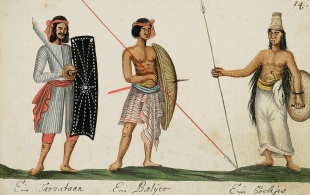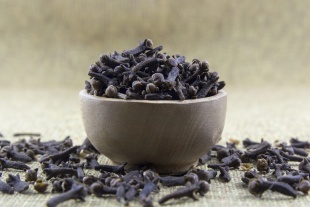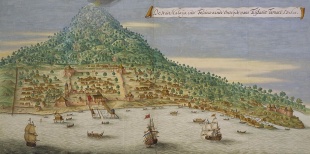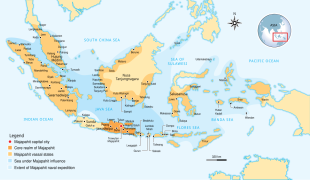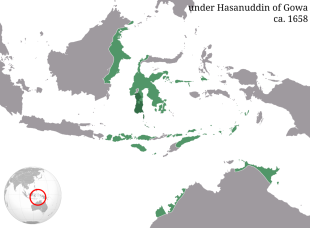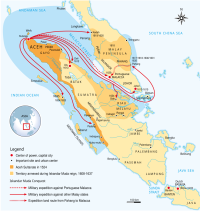CONTROL OF THE SPICE TRADE BY INDONESIAN STATES
Until the challenge of direct traders from Europe (first the Portuguese and Spanish at the beginning of the sixteenth century, then the Dutch, English, and others at the end of it) and renewed interest from the Chinese (after the Ming government relaxed prohibitions on private overseas trade in the mid-sixteenth century), Indonesians held virtually exclusive control of the spice trade, and decisive power in the extensive exchange of luxury and bulk goods that accompanied it. [Source: Library of Congress *]
Over a period of about 250 years, however, they gradually lost their commercial primacy and, in some cases, much of their political independence. This crucial process was far too complex to be understood simply as a struggle between East and West, or Christianity and Islam, or “modern” and “traditional” technology.
Europeans not only warred vigorously among themselves, but they routinely allied themselves with local powers, many of them Muslim, and became participants in local rivalries; they also frequently found that their weaponry did not give them obvious superiority over indigenous powers, who purchased both light and heavy firearms and sometimes, as in Java well into the eighteenth century, were able to manufacture serviceable copies of European models. Europeans found their position fluctuated as a result of a multitude of factors, some of them well beyond their control.
RELATED ARTICLES:
SPICES, TRADE AND THE SPICE ISLANDS factsanddetails.com
CLOVES, MACE AND NUTMEG: THE SPICE ISLANDS SPICES factsanddetails.com
EARLY INDIANS, CHINESE AND ARABS IN INDONESIA: IBN BATTUTA, YIJING, ZHENG HE factsanddetails.com
EARLY EUROPEAN EXPLORERS IN INDONESIA: MARCO POLO, NICOLÒ DEI CONTI, MAGELLAN'S CREW factsanddetails.com
AGE OF EUROPEAN EXPLORATION factsanddetails.com
PORTUGUESE IN INDONESIA factsanddetails.com
PORTUGAL AND THE AGE OF DISCOVERY factsanddetails.com
PORTUGUESE TRADE EMPIRE IN ASIA factsanddetails.com
EARLY DUTCH PERIOD IN INDONESIA AND THE DUTCH EAST INDIA COMPANY (VOC) factsanddetails.com
DUTCH EMPIRE: WEALTH, EXPLORATION AND HOW IT WAS CREATED factsanddetails.com
DUTCH, THE SPICE TRADE AND THE WEALTH GENERATED FROM IT factsanddetails.com
END OF THE DUTCH EAST INDIA COMPANY, BRITAIN IN INDONESIA AND THE JAVA WAR factsanddetails.com
NETHERLANDS INDIES EMPIRE IN THE 19TH CENTURY factsanddetails.com
INDONESIA UNDER DUTCH RULE IN THE EARLY 20TH CENTURY factsanddetails.com
RISE OF INDONESIAN NATIONALISM IN THE EARLY 20TH CENTURY factsanddetails.com
MATA HARI factsanddetails.com
Indonesia When Europeans Arrived in the 16th and 17th Centuries
At the time the first European explorers arrived in Indonesia in the 16th century, the archipelago was a fragmented amalgamation of kingdoms, sultanates and principalities, the most powerful of which had grown rich from trade and maintained power with strong naval forces. The period between the mid-15th century and the end of the 18th century was a time of turbulence and profound change for the archipelago. Java lost much of its commanding position as new states, some great and some small, also raced to acquire wealth and exercise power. Urban populations grew rapidly, and with them the influence of expanding commercial elites.
New technologies, for example in weaponry and ship design, changed the face of trade. And Islam extended its reach at the same time as a wide variety of influences diversified and secularized culture. It was also a time in which Europeans began to play a direct role in the archipelago’s affairs, although they did not rule it, and Chinese merchants and laborers became more important. All of this took place in the context of a commercial boom that greatly expanded prosperity but also greatly heightened competition and exposed Indonesia directly to the swift and often dangerous currents of what might justifiably be called the “first globalization”. [Source: Library of Congress *]
Over the course of the seventeenth century, indigenous and outside powers engaged in a multifaceted struggle for control of maritime trade. Rapidly rising profits from this trade fueled the growth of ambitious states, the most important of which were Aceh (northern Sumatra), Banten (western Java), Makassar (southern Sulawesi), and Mataram (central and eastern Java). The most important outside power was the Dutch- run United East Indies Company (VOC). Each of the indigenous states experienced a slightly different trajectory during this period, but the essential contest was between a pattern of heavily state-controlled trade on the one hand and, on the other, a still tentatively oligarchical pattern, in which the so-called “orang kaya” or merchant elite, and often allied religious and traditional elites, played significant political and economic roles. *
Europeans and the Spice Islands
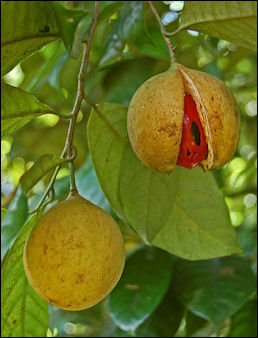
Nutmeg on a tree The first European boats arrived following a demand for Indonesian spices, especially nutmeg and cloves—stimulating trade relations with the eastern islands of Maluku (the famed “Spice Islands”) beginning in the sixteenth century. The seas became avenues for widespread penetration of European ships with advanced naval technology. This enabled conquest of people throughout the archipelago, followed by colonialism. [Source: “Culture and Customs of Indonesia” by Jill Forshee, Greenwood Press, 2006]
The Portuguese were followed by Spanish, who claimed Portuguese territories when Philip II assumed the Portuguese crown in 1580. Like, the Portuguese, the Spanish established themselves by building forts and trading out of them. Later the British and Dutch fought over them and the Spanish retreated to the Philippines. The Dutch took possession of many of the Portuguese forts by force. The English took a few islands in the Moluccas in the early 1700s and later established a short-lived colony of Sumatra. They didn’t stay long and focused their attention on Malaysia.
According to some scholars the spice trade before the Age of Discovery was peaceful and profitable to a large number of people until the Portuguese, Dutch, Spanish and English tried to bypass the traditional trade routes and set up monopolies. The voyages to the spice islands were financed by investors that included royal families, brokers and bankers. The profits were enormous if a ship actually returned with spices because the risks were enormous. Ships were lost to storms and reefs. If the managed to make it to their destinations in the Far East they were often robbed of their cargos by Asian and European pirates on the way back.
Deals Made Between Europeans and the Spice States
Some of these complexities of controlling the spice trade—and maintaining a presence in Indonesia—can be glimpsed in a brief history of Ternate, Maluku, in the sixteenth and early seventeenth centuries. In 1512 seven Portuguese arrived in Ternate as the guests of Sultan Abu Lais (r. ?–1522), having been rescued by fishermen from a shipwreck of their locally built vessel (their original ship had become too unreliable to continue in service) loaded with spices purchased in Banda. The sultan sought an alliance with the Portuguese, of whom he had already heard, and was eager to exchange cloves for assistance against the rival sultanate of Tidore. [Source: Library of Congress *]
When Spanish ships arrived in Maluku in 1521, Sultan Mansur of Tidore sealed a similar agreement with them, to which the Portuguese soon responded by building a large stone fortress on Ternate. This act touched off decades of warfare among Europeans and their local allies, in which political control, economic ascendancy, and religious identity all were contested. But it also brought change in Ternate itself, for the ruler there became essentially a prisoner of the Portuguese, whose increasingly arbitrary and oppressive interference in local affairs, including spice production and harvesting, eventually turned their former allies against them. *
Under the leadership of Sultan Babullah (r. 1570–83), Islam became a powerful tool with which to create alliances and gather widespread opposition to the Portuguese. After a siege in 1575 against the Ternate fort, he ousted the Portuguese forces. Babullah allowed a limited contingent of Portuguese merchants to continue trading in Ternate, but the fort became the royal residence, and the sultanate rapidly expanded its reach to key trading ports as far away as northern and southern Sulawesi until the arrival of the Dutch touched off new and even more complex struggles. *
In the seventeenth century, English and Portuguese merchants traded for spices and enslaved people with the inhabitants of parts of islands such as Sumba and Sumatra where Islam had not yet taken hold. [Source: Eric A. Powell, Archaeology magazine, July-August 2024]
See Separate Article CLOVES, CINNAMON, MACE AND NUTMEG: THE SPICE ISLANDS SPICES factsanddetails.com
Islam, Europeans and Indonesia
In the early fifteenth century, a Srivijayan prince established the port city of Melaka on the Malay Peninsula. It quickly became Southeast Asia’s most important trading hub, commanding commerce from every direction and drawing merchants from around the world. Melaka’s early rise owed much to Chinese protection and trade, but in 1511 the Portuguese conquered the city. Its rulers and many residents retreated upriver to form a new settlement, leaving the Portuguese in control of one of the region’s most profitable commercial crossroads. [Source: “Culture and Customs of Indonesia” by Jill Forshee, Greenwood Press, 2006]
Melaka’s fall to Catholic Portugal sent shockwaves through the archipelago, fueling Islamic revival and strengthening Muslim sultanates such as Aceh and Minangkabau in Sumatra, Banjarmasin in Kalimantan, Makasar and the Bugis states in Sulawesi, Ternate and Tidore in Maluku, and numerous Javanese kingdoms. Aceh, in northern Sumatra, waged continuous war against the Portuguese until joining the Dutch assault that finally captured Melaka in 1640. Yet the Dutch kept the city for themselves, leaving Aceh to drift into decline.
By the fifteenth century, Islam had spread widely across Indonesia, especially in port towns. Many were drawn to the religion’s promise of equality in societies long dominated by rigid hierarchies. In practice, however, Islam did not initially liberate ordinary people from entrenched aristocratic power. In Java, Muslim nobles became known as the priyayi, and Islamic kings ruled from palace courts through the same feudal structures that had shaped the island for centuries. As before, the new religion blended with older Javanese mysticism and adapted to local realities.
In southern Sulawesi, the Muslim Makasar empire of Gowa became a major power between 1550 and 1660, supported by a strategic port and capable leadership. Their rivals, the Bugis—also Muslims—were skilled seafarers. Like much of Indonesia, Sulawesi practiced slavery, with people captured in war or born into servitude traded across the islands. South Sulawesi peoples were renowned shipbuilders and navigators; both Makasar and Bugis sailors ventured to West Papua for slaves, migrated widely throughout the archipelago, and even reached northern Australia by the seventeenth century to harvest sea cucumbers (trepang) for trade with China. Some settled there, leaving lasting linguistic and cultural influences in Aboriginal communities, while also bringing Australians back to Sulawesi.
Through these far-reaching voyages, Indonesian ships carried Islam, goods, and ideas throughout the archipelago and brought diverse peoples into contact. They also spread Malay, the lingua franca of trade, which foreigners used to communicate and govern. Over time, Malay developed into Bahasa Indonesia, now the national language, spoken alongside hundreds of local languages throughout the country.
Spices and the Opening Up of Indonesia
The early modern age of commerce in Indonesia was initially fueled by the buying and selling of Indonesian spices, the production of which was limited and the sources often remote. Nutmeg (and mace) come from the nut of the tree “Myristica fragrans”, which, until the late eighteenth century, grew almost exclusively on six tiny islands in the Banda Archipelago, some 300 kilometers west of the Papua coast. Cloves are the dried flower buds of the tree “Syzygium aromaticum”, the cultivation of which until the mid-seventeenth century was largely limited to a handful of small islands off the west coast of Halmahera in the Maluku Islands. [Source: Library of Congress *]
These spices had long been distributed in modest quantities via the trade networks of the archipelago. After about 1450, however, demand and the ability to pay for them climbed rapidly in both China and Europe. In the century between the 1390s and the 1490s, for example, European imports of cloves rose nearly 1,000 percent, and of nutmeg nearly 2,000 percent, and continued to rise for the next 120 years. Another product, black pepper “(Piper nigrum”), was grown more easily and widely (on Java, Sumatra, and Kalimantan), but it too became an object of steeply rising worldwide demand. These changing global market conditions lay at the bottom of fundamental developments, not only in systems of supply and distribution but in virtually all aspects of life in the archipelago. *
Cloves were the most valuable early spice. They originated from the islands of Ternate, Tidore and Bacan in the Mollucca group in Indonesia. Before the birth of Christ, visitors to the Han Dynasty court in China were only permitted to address the emperor if their breath has been sweetened with “odoriferous pistols” — -Javanese cloves. Because of limited geographical range cloves didn’t make their way to Europe until around the A.D. 11the century. They were introduced by Arab traders who controlled the trade of many spices to Europe.
During the Middle Ages, Chinese, Arab and Malay traders purchased nutmeg in what is now Indonesia and Southeast Asia and carried it in boats to the Persian Gulf or by camel and pack animal on the Silk Road. From the Gulf the spices made their way to Constantinople and Damascus and eventually Europe.
For a long time the spice trade was controlled by north Moloccan sultanates, name Ternate, founded in 1257, and Tidore, founded in 1109. Both were based on small islands and often fought among themselves. Their most valuable crop was cloves. Protecting their kingdoms were fleets of kora-kora , war canoes manned by over 100 rowers. The sultans relied on Malay, Arab and Javanese merchants to distribute their goods.
Ternate and Tidore
Ternate and Tidore islands were the home of powerful rival Muslim sultanates in pre-European times. Their influence at one time extended to the Philippines, Sulawesi and New Guinea. They were the two most powerful of the four kingdoms that controlled the clove trade until the arrival of Europeans in the 16th century. They held their own in battles against the Portugese and Spanish in the 1500s, but were eventually defeated by the Dutch and came under colonial rule.
The Ternatan and Tidorese of two small islands in the North Moluccas: Ternate and Tidore. Also known as Orang Ternate, Orang Tidore, Suku Ternate and Suku Tidore, they distinguish themselves from the islanders around them by the use of the Ternatan and Tidorese languages and their link to historical kingdoms. The Ternatan and Tidorese are closely linked culturally but neither likes to be confused with the other.
Since early in the last millennium, the small islands of Ternate and Tidore in the Moluccas were the only source for cloves in the world. Indian, Arab, Chinese and Javanese merchants used to call on these islands to carry home this precious cargo which sold at exorbitant prices in Europe and the Orient. Cloves, together with nutmeg and mace from the Banda islands were used to flavor and preserve food, as medicines and even as aphrodisiacs. But after the Crusades, the trade route to the Far East was blocked for the Europeans, so the Portuguese, Spaniards, British and the Dutch were determined to discover for themselves the fabled Spice islands.
Vasco da Gama was the first to sail around the Cape of Good Hope in Africa to reach India. Then, from India, the Portuguese finally found the route to the Moluccas in 1521, and arrived in the spice islands of Ternate and Tidore and the Banda islands, then the only source for nutmeg and mace. To get there, the Portuguese seafarers traveled 14,000 kilometers - nearly 9,000 miles “ crossing uncharted seas, and overcoming storms, high swells and tropical monsoons.
At the time, there was already a thriving sultanate (kingdom) on Ternate. But with the arrival of the Spaniards, the Dutch and the British, the fight began among the European powers for the monopoly of the spice trade, which was finally wrested by the Dutch. Towards the end of the 16th century, Dutch governor general Jan Pieterszoon Coen replanted cloves to Ambon where the Dutch were in control, then brutally wiped out all the clove plants on Ternate and Tidore, These actions, known as the hongi expeditions, instantly doused the domination of the sultanates of Ternate and Tidore and decimated the main income of the islands’ population. From that time onwards, Ternate and Tidore became forgotten pages in history.
See Separate Article MOLUCCAS factsanddetails.com
Melaka
By the 15th century the predominate power in Indonesia was Melaka (Malacca), the trading kingdom based on the Malay peninsula. The Melaka kingdom controlled the strategic shipping lanes of the Malacca Straits and important commercial ports on northern Java. By the 16th century Melaka was the supreme power in Southeast Asia and Indonesia.
Prof. Dr. Nazeer Ahmed, PhD wrote in the Encyclopedia of Islamic History: Around the year 1390, a prince from Java, Parameswara, was forced to flee his homeland. Landing on the west coast of Malaya with a loyal following of about a thousand young men, the prince lived off piracy for almost ten years. At that time, Siam (modern Thailand) was the imperial power in the area. Parameswara drove out the Siamese and established the town of Melaka in 1403. The name Melaka derives from the Arabic word Malakut-meaning market place. The Arabs had maintained a trading colony there since the 8th century.
“Once settled, the prince encouraged peaceful trade. The fame and fortune of the trading post grew until it attracted international attention. The Muslims dominated the trade in the Indian Ocean. Arabic had become the lingua franca of traders in this region. Islam was gaining a following in the islands of Indonesia. Across the Straits from Melaka, the powerful Muslim kingdom of Aceh was emerging. Local folklore has it that around the year 1405, Prince Parameswara fell in love with a princess from the court of Pasai, accepted Islam, married her and changed his name to Sultan Iskander Shah.
See Separate Article EARLY EMPIRES AND THE ARRIVAL OF ISLAM IN MALAYSIA factsanddetails.com
Majapahit Kingdom
The Majapahit Kingdom (1293-1520) was perhaps the greatest of the early Indonesian kingdoms. It was founded in 1294 in East Java by Wijaya, who defeated the invading Mongols but was in its last gasps when Europeans began arriving in the late 15th and early 16th centuries. . Under the ruler Hayam Wuruk (1350-89) and the military leader Gajah Mada, The Majapahit Kingdom expanded across Java and gained control over much of present-day Indonesia—large parts of Java, Sumatra, Sulawesi, Borneo, Lombok, Malaku, Sumbawa, Timor and other scattered islands—as well as the Malay peninsula through military might. Places of commericial value such as ports were targeted and the wealth gained from trade enriched the empire.
The Majapahit Kingdom Empire was centered at Trowulan near the present-day city Surubaya in East Java. Some look upon Majapahit period as a Golden Age of Indonesian history. Majapahit’s ships carried bulk goods, spices, and other exotic commodities throughout the region
Local wealth came from extensive wet rice cultivation and international wealth came from the spice trade. Trading relations were established with Cambodia, Siam, Burma and Vietnam. The The Majapahits had a somewhat stormy relationship with China which was under Mongol rule.
Despite its grandeur, Majapahit’s fortunes eventually declined as conditions in the archipelago shifted. The booming international spice trade in the eastern islands grew so vast that Majapahit could no longer control it, especially once European ships arrived and disrupted existing networks of power. Coastal ports gained influence, maritime trade routes shifted, and the political balance tilted away from inland Java. [Source: “Culture and Customs of Indonesia” by Jill Forshee, Greenwood Press, 2006]
Majapahit did not unify the archipelago in any modern sense, however, and its hegemony proved in practice to be fragile and short-lived. Beginning shortly after Hayam Wuruk’s death, an agricultural crisis; civil wars of succession; the appearance of strong trading rivals, such as Pasai (in northern Sumatra) and Melaka (on the Malay Peninsula); and restive vassal rulers eager for independence all challenged the political-economic order from which Majapahit had drawn much of its legitimacy. Internally, the ideological order also began to falter as courtiers and others among the elite, perhaps following popular trends, abandoned Hindu-Buddhist cults centered on a supreme kingship in favor of ancestral cults and practices focused on salvation of the soul. In addition, new and often intertwined external forces also brought significant changes, some of which may have contributed to the dissolution of Majapahit’s paramountcy. [Source: Library of Congress *]
Makassar and Gowa
By the end of the 16th century, a new sea power had emerged on Sulawesi: the twin principalities of Makassar and Gowa, which had been settled by Malay traders and whose commercial realm spread well beyond the region. In 1607, the explorer Torres met Makassar Muslims on New Guinea.
The first mention of the Makassar is around 1400. At that time there were a number of Makassar principalities, each of which was said to have been founded by a princess or prince who descended from heavenly beings. Islam arrived in 1605.
The Makassar state of Gowa became the most powerful state in Indonesia, outmuscling its rivals the Bugis of southeastern Sulawesi and exerting control over much of what is now eastern Indonesia in the 16th and 17th century. Early European explorers to the region encountered Makassar fleets trading as far east as New Guinea and as far south as Australia. The Makassar were among the first outsiders to have contact with Australian Aborigines, introducing metal tools, pottery and tobacco to them. Gowa endured until it was defeated by Dutch and Bugi forces in 1669.
The Makassar live in southwestern Sulawesi. Also known as the Macassarese, Makassaren, Makassarese, Mangkasaren, they once ruled a powerful maritime kingdom and have traditionally been rivals and cultural cousins of the Bugis. The have traditionally occupied an area of southern peninsula of Sulawesi south of the area occupied by the Bugis. Their name for themselves is “Tu Mangkasara,” meaning “people who behave frankly.” They number about 2 million, with many living outside of Sulawesi. The Makassarese, have their own language and shared an ancient written language with the Bugis. As is true with the Bugis the have been staunchly Islamic and independent minded and the rhythm of their agricultural and maritime life is influenced by the monsoon seasons.
The Dutch East India Company viewed Gowa as a threat to its spice monopoly. It allied itself with a Bugi prince to fight them. After a year of fighting the sultan of Gowa was forced to sign the Treaty of Bungaya in 1668 that greatly reduced Gowa’s power and gave the Dutch control of sea lanes and the sources of spices that it wanted.
After that the Makassar periodically rebelled and were not brought under Dutch control until 1906 when Dutch forces conquered the interior of their homeland and killed the king of Gowa. Colonialism was only made possible by the incorporation of Makassarese nobles into the colonial system. Even today Makassar nobles occupy many positions of authority in the Indonesian government.
Mataram Sultanate
In the early seventeenth century, the most powerful state in Central Java was the Mataram Sultanate, whose rulers cultivated friendly relations with the Pasisir states, especially Gresik, and tolerated the establishment of Islamic schools and communities in the countryside. Tolerance may have been motivated by the rulers' desire to use the schools to control village populations. Muslim groups in the interior were often mutually antagonistic, however, and sometimes experienced official persecution. The greatest of Mataram's rulers, Sultan Agung (reigned 1613-46), warred against various Javanese states and defeated as many as he could. Without shedding the Hindu-Buddhist or Javanese animist attributes of kingship, he sought and received permission from Mecca to assume the Islamic title of sultan in 1641. *
The Mataram Sultanate rose in the 16th century on Java and enduring through the early colonial period until the 18th century. First the Portuguese and then Dutch dominated trade during this period. The Dutch East India Company weakened and ultimately took control of the Mataram Sultanate by dividing it into vassal states around 1750. It later came under the control of Dutch colonial government.
In the Mataram Sultanate, peasants were ruled by a landed nobility or gentry loyal to the king. The king alloted land to some family members. The port towns were ruled by princes even though trade there was dominated Chinese, Malays and Indians. This pattern endured through the colonial period.
In addition to the peasantry there were two main clases: prijaji, descendants of precolonial administrative gentry, who served as bureaucrats; and a class of nobles that could trace their ancestry to rulers of the Mataram Sultanate.
Bali Hindu Kingdom
When the Portuguese arrived in Bali in 1512, the island wasn't a single kingdom but a collection of independent Hindu-Buddhist kingdoms, with the powerful Gelgel Kingdom being a dominant force, ruling over much of Bali and surrounding areas, led by rulers like the Dewa Agung, who interacted with the stranded Portuguese sailors in 1585. Bali wasn't involved so much in the spice trade.
The indigenous people of Bali came into increasing contact with people from Java around the A.D. 5th century and were influenced by the Hindu and Buddhist religions found there but also by the language and political traditions associated with them. It is not known whether people that introduced these traditions were Indians or Javanese or both. In the A.D. 11th century, Airlangga, the son of a Balinese king and a Javanese queen, united Bali with an eastern Javanese kingdom. At the age of 16 Airlangga fled to the forests of western Java when his uncle lost the throne and later reclaimed the throne and became one of Java’s rulers. For three centuries Bali was mostly at least semi-independent and intermittently ruled by the Java-based Majapahit kingdom, which was conquered by Muslim forces in 1527. When the Majapahit Empire fell many Javanese princes and officials and intellectuals fled eastward to Bali.
For three centuries Bali endured as a Hindu kingdom while the rest of Indonesia became by Islamicized or Christianized. Periodically Bali was dominated by other kingdoms. It in turn influenced other islands, namely Lombok, and enslaved some of its own people. In the 16th century, a ship full of Dutchmen accidently landed on Bali and fell so deeply in love with the place they stayed for two years, and when it was time to leave some refused to go. Bali at that time was regarded to be at its peak. The king of the island had 200 wives, traveled around in a chariot pulled by two white buffalo and had at his disposal a retinue of 40 dwarves.
Aceh
The Acehnese had their first sultan in the 16th century. He ruled over a sultanate established around a harbor and challenged the sultanate of Melaka for control of trade in the region. To mark a trade agreement with England in 1585 the sultanate sent the following message to Queen Elizabeth : “I am the mighty rulerof the regions below the wind, who holds sway over the land of Aceh and over the land of Sumatra an over all the lands tributaries of Aceh, which stretch from the sunrise to the sunset.” By the 17th century Aceh was a reasonably large sultanate, with 800-man galleys, cavalries with Persian horses, elephant corps and conscripted soldiers. It controlled much of Sumatra, the Malacca Straits and parts of the Malay Peninsula and from that point was involved in a number of conflicts and intrigues with the Portuguese, Dutch and English. *
Aceh arose in the middle of the sixteenth century, partly as an effort to control dissension among northern Sumatran and Malay polities and partly to control the Malay trade, which had dispersed after 1511. (Although Aceh’s rulers were often serious about promoting Islam, their major military efforts were over commercial rather than religious affairs, and were directed against Muslim as well as Christian rivals.). [Source: Library of Congress *]
Aceh reached its apogee under Sultan Iskandar Muda (r. 1607–36). He pursued an aggressive military policy against neighboring powers, including Portuguese Melaka; he presided over a centralized and increasingly authoritarian state; he exercised arbitrary power, including attempting to establish royal monopolies, over the trading activities and even the private property of the “orang kaya”. He invested in huge, heavily armed seagoing ships—one, called “Terror of the Universe”, was more than 90 meters long and carried more than 700 men—of new design to compete with European and Chinese vessels. The sultan also practiced an assertive foreign policy, playing European and Asian powers against each other.
The ruthlessness of Iskandar Muda’s regime made many enemies, however, and nearly caused a civil war. Its economic gains, rather than bringing about a permanent transformation of the political and economic structure of Aceh, proved ephemeral. The “orang kaya” reasserted themselves and sought ways to restrict royal power. Until the end of the seventeenth century, for example, they successfully sponsored a succession of female rulers, perhaps because they considered women to be either more moderate or more easily manipulated than men. *
But in the eighteenth and nineteenth centuries, both their influence and that of the court declined as that of hereditary district chiefs (“uleëbalang”) and Muslim leaders rose. The Acehnese state thus lost its imperial authority and much of its political coherence. Nevertheless—and unlike most of its contemporary regional states—Aceh remained an important local power and continued to be an economic force to be reckoned with, for example producing more than half the world’s pepper supply as late as about 1820. Aceh did not hesitate to ally itself with Dutch forces in an attack on Portuguese Melaka in 1641, but in subsequent years it alone among the great nascent states of the early modern archipelago managed to avoid entanglement with the VOC, retaining its independence until the late nineteenth century. *
Image Sources: Wikimedia Commons
Text Sources: New York Times, Washington Post, Los Angeles Times, Times of London, Lonely Planet Guides, Library of Congress, Compton’s Encyclopedia, The Guardian, National Geographic, Smithsonian magazine, The New Yorker, Time, Newsweek, Reuters, AP, AFP, Wall Street Journal, The Atlantic Monthly, The Economist, Global Viewpoint (Christian Science Monitor), Foreign Policy, Wikipedia, BBC, CNN, NBC News, Fox News and various books and other publications.
Last updated December 2025


